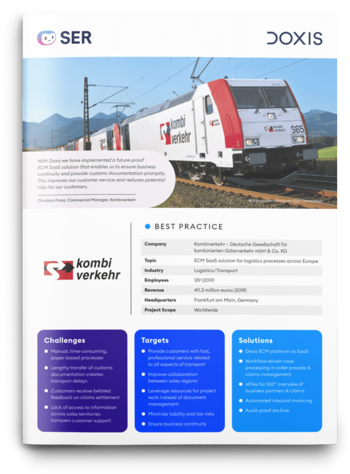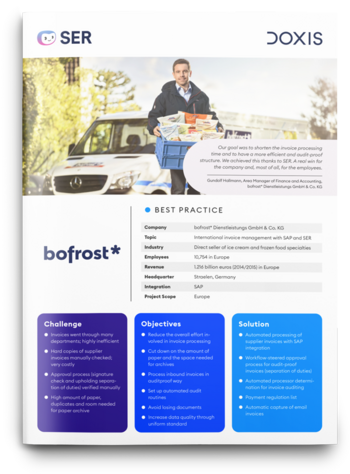SER Blog Customer Stories & Use Cases
EDI – Electronic data interchange based on international standards
When businesses exchange information with each other on a regular basis, manual processes can prove error-prone and time-consuming. It's a different story with EDI. This form of electronic data transmission creates a standardized format for transmitting business information between two companies automatically, securely and globally.
So keep reading to learn how electronic data interchange works and how you can incorporate EDI in your business processes.

Principles of electronic data interchange
EDI is the abbreviation for electronic data interchange. By definition, EDI is a standard electronic format that enables businesses to exchange data in documents between software applications.
How does EDI work?
EDI transactions work by exchanging data and documents based on standardized rules and protocols. These are called EDI message standards. The message standards ensure that documents are processed properly. If not, the data transfer will fail.
An EDI message standard, for example, is the structure in which information appears in a document format. Using standardized structures, businesses send, receive and process information regardless of the software system selected.
A distinction should be made between two types of EDI transmissions:
- Direct connection: Two computer systems exchange data directly between themselves.
- Value-added-network (VAN): Two computer systems exchange data with each other via a middleman.
The technology behind EDI
To ensure that businesses exchange data securely via direct connections or a VAN, EDI uses transmission protocols. These protocols regulate how data is transmitted over the internet or private networks and provide a secure data interchange. For example, transfer protocols such as AS2, FTP and OFTP have functions that encrypt data and check the integrity of the information.
Another security feature in EDI data exchange is the digital signature. The purpose of the EDI signature process is to clearly identify the sender of a message. This enables EDI to check the integrity of the information and determine whether the source of the file is genuine.

kombiverkehr: ECM SaaS solution for logistics processes across Europe
Find out how Kombiverkehr uses Doxsi4 SaaS to ensure business continuity, contactless logistics processes and smooth collaboration with authorities and service teams.
Read nowInternational standards for EDI
International standards for EDI define the rules and regulations that apply to EDI data exchange. The most important EDI standards are EDIFACT, ANSI X12 and XML.
EDIFACT
EDIFACT stands for electronic data interchange for administration, commerce, and transport. This EDI standard was developed by the UN and is recognized around the world. It uses clearly defined data structures – starting with message types.
EDI message types in EDIFACT always consist of six capital letters. For example, “FINSTA” stands for a bank statement and “PAYMUL” stands for payment orders. The message structure is also clearly defined. It's divided into segments such as “UNT,” the end of a message, or “UNH,” the header data in a message.
ANSI X12
Compared to EDIFACT, ANSI X12 is used mainly in parts of North America. ANSI X12 stands for American National Standards Institute X12. This standard is used mostly in industries such as healthcare, insurance and retail.
Similar to EDIFACT, ANSI X12 relies on standardized and fixed formats for data interchange. Message types are numbered in this standard, for example, “850 Purchase Order,” “856 Advance Shipping Notice,” and “997 Functional Acknowledgment”.
XML
XML, short for extensible markup language, is the most flexible message format. Unlike EDIFACT and ANSIX12, it allows more flexible hierarchical structures. E-commerce businesses, financial service providers and even telecommunications companies use the EDI standard to create customized message formats.
XRechnung, a German standardized format for eInvoices, is based on the XML format. Since it's a text-based format, it is easy to read for humans and machines. The markup language is always between two angle brackets “</>”.
EDI-supported message types
When companies exchange business data via the EDI system, whole information flows are created. These reproduce, in part or even completely, the communication processes between organizations. For example, EDI messages can be used to track documents that two business partners exchange with each other, from the initial inquiry to goods receipt and final invoice. Learn how this works based on an order process in the supply chain.
Hey Doxi, how can EDI-supported message types be used to exchange business documents?
- PRICAT – Price catalog: The message is used to exchange business documents and information about items, their prices, and information such as units of measure.
- ORDERS – Order: Buyers use this message type to send their orders to suppliers. It contains details such as delivery terms, product, and quantity.
- DESADV – Despatch advice: Suppliers send this EDI message to buyers to notify them that their product orders have shipped. Components of the message include, for example, tracking numbers, a list of goods ordered, and the expected delivery date.
- RECADV – Receiving Advice: Buyers send a message to suppliers to confirm receipt of delivered orders. In the exchange, buyers mention, for example, whether goods are complete or damaged.
- INVOIC – Invoice: Suppliers then send the buyers the invoice for the fully delivered goods as an EDI message.
Benefits of EDI
Whether electronic invoices, delivery notes, bank transfers or contracts, EDI transfers data between business partners electronically and in a standardized format. The EDI process is indispensable particularly for large businesses that exchange high volumes of data in B2B partnerships.
- It makes it faster to send business documents such as delivery notes between business partners.
- It increases the efficiency of data interchange through automation.
- It improves data quality through proper governance processes.
- It reduces errors, costs, re-entry, and input errors when transmitting data.
Also, the digitization of business processes is safer and faster than exchanging paper documents could ever be.
EDI application areas in businesses
In practice, EDI is primarily designed to increase the automation of processes related to delivery, supply chain and invoicing.
Businesses exchange messages in the following areas, for example:
- Procurement and supply chain management: orders, inventory data, delivery scheduling
- Invoicing and payment processing: electronic invoices, reminders, payment confirmations
- Logistics and transport: shipping orders, customs documents, transport data

bofrost*: Automated inbound invoice processing with ECM & SAP
Read all about how bofrost* automates its invoice processing with Doxis, saving time and money along the way
Read nowIncorporating EDI in businesses
To exchange messages in EDI format, partner companies first need to agree on the format they plan to use to exchange data. Different industries and even the partners often use individual standards. This can make it difficult to incorporate EDI in a business.
For this reason, businesses rely on EDI providers and systems that integrate EDI in existing business processes and IT infrastructure.
- EDI converter: converts information from internal company application documents to a standardized format.
- Trading partner agreements: defines how businesses send transmission and business protocols and the standard they have to follow.
- Batch enveloping and de-enveloping: groups message batches so that each message reaches the right recipient.
EDI for your ECM system
Once implemented, businesses can exchange messages via EDI based on a uniform standard. The data interchange is usually performed via the separate ERP systems. This is why leading systems such as Microsoft Dynamics or SAP have EDI interfaces.
In the background, the enterprise content management system (ECM) or the document management system (DMS) manages the flow of information. As a result, the ECM system or DMS also serves as the document archive for ERP systems. This means the archive also has to support EDI.
Doxis as ECM system for EDI
Doxis as ECM solution supports EDI data exchange. This enables you to manage your business-related documents at a central location. This simplifies, for example, contract management and supplier management, and serves as a solution for managing inbound invoices. In Doxis, for example, you receive invoices via EDI, which you then process as usual.
Using EDI for ERP-to-ERP data exchange
EDI is already considered one of the key data exchange functions in B2B. EDI is becoming more and more important, especially in the supply chain sector. In order to set up processes with EDI securely and automatically, IT systems such as ERP software and ECM software have to support the standardized format. Doxis provides an end-to-end approach to digitalization and ensures that you can count on the leading messaging standard in the B2B segment.
Discover how seamless and efficient your business data exchange can be with Doxis. Book a demo now and see our EDI solutions in action
The latest digitization trends, laws and guidelines, and helpful tips straight to your inbox: Subscribe to our newsletter.
How can we help you?
+49 (0) 30 498582-0Your message has reached us!
We appreciate your interest and will get back to you shortly.




